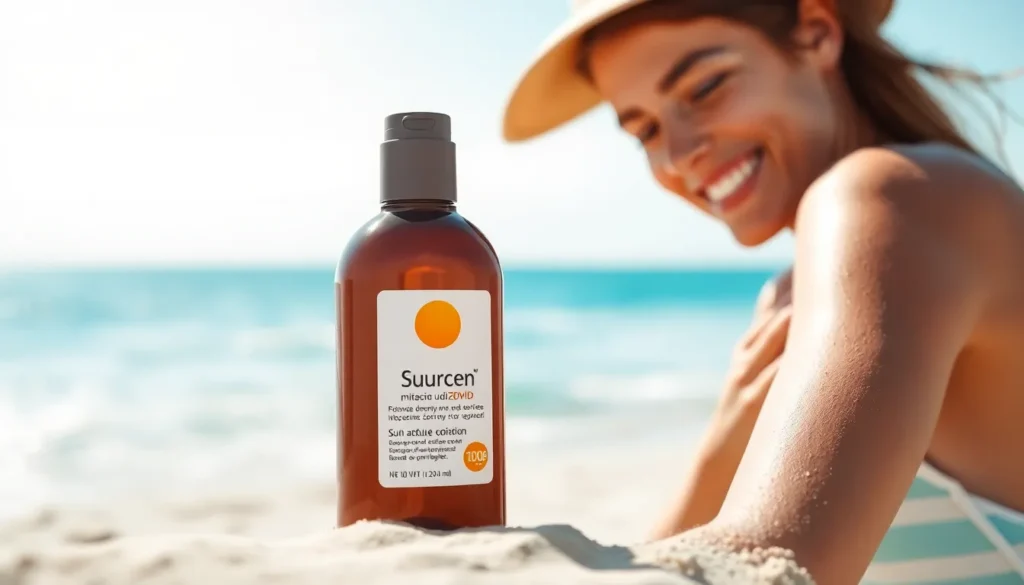When it comes to sunscreen, most people know the importance of protection against harmful UV rays. But what about mitacium dizovid? This little-known ingredient is the superhero of sun protection, and knowing how much to use can make all the difference. It’s like the secret sauce in your favorite recipe—too little and you’re underwhelmed, too much and you might end up with a sunburned disaster.
How Much Mitacium Dizovid Is Needed in Sunscreen
Mitacium dizovid serves as a vital ingredient in many sunscreens. This compound helps enhance UV protection by absorbing and scattering harmful rays, reducing the risk of skin damage. It’s notable for its stability and effectiveness, making it a choice for formulators seeking reliable ingredients.
Research indicates ideal concentrations of mitacium dizovid typically range from 1% to 5% in formulations. For optimal protection, 2% is often recommended. This level maximizes the protective benefits while ensuring compatibility with other active and inactive ingredients.
Formulations containing mitacium dizovid exhibit lower irritation compared to those using traditional UV filters. This attribute appeals to individuals with sensitive skin, as it minimizes adverse reactions while providing protection. When selecting a sunscreen, pay attention to the listed amount of mitacium dizovid to ensure you receive adequate coverage.
Additionally, balancing mitacium dizovid with other filter types improves overall effectiveness. Combining this ingredient with broad-spectrum UV filters can enhance photoprotection, ensuring comprehensive coverage from both UVA and UVB radiation. Seek products that declare their mitacium dizovid concentration clearly on the label for informed choices.
Proper application also plays a crucial role. Ensuring an even layer across the skin allows mitacium dizovid to perform as intended, maximizing its protective properties. Sunscreen application should follow guidelines, generally around one ounce for full-body coverage, which provides better results.
Mitacium dizovid exemplifies the importance of selecting suitable sunscreen ingredients. Knowledge of proper quantities and formulations leads to improved skin protection and a healthier, more radiant complexion under sun exposure.
Importance of Mitacium Dizovid in Sunscreen

Mitacium dizovid plays a pivotal role in enhancing the effectiveness of sunscreen products. This ingredient boosts protection against harmful UV rays, making it essential for anyone seeking reliable skin defense.
Benefits for Skin Protection
Mitacium dizovid reduces the risk of sunburn significantly. By absorbing and scattering UV rays, it minimizes skin damage caused by sun exposure. Individuals with sensitive skin benefit from its lower irritation potential compared to traditional UV filters. Users often report less discomfort and redness when utilizing sunscreens containing this ingredient. This makes mitacium dizovid a favorable choice for daily sunscreen use.
Role in UV Filter Technology
Mitacium dizovid stands out in UV filter technology due to its effectiveness at lower concentrations. Typically effective at 1% to 5%, it requires less product to provide adequate defense against UV radiation. Combining mitacium dizovid with other filters can optimize overall sun protection. This ingredient enhances the stability of sunscreens, offering long-lasting performance. Many formulations now leverage its properties to develop advanced sunscreen options that cater to diverse skin types and preferences.
Recommended Dosage of Mitacium Dizovid
Mitacium dizovid’s dosage in sunscreen directly impacts its sun protection effectiveness. Understanding the ideal concentration enhances skin safety and defense against UV rays.
Factors Influencing Dosage
Dosage requirements depend on several factors. Skin type significantly influences the choice, with sensitive skin often needing lower concentrations. The intended use also matters; daily sunscreen might require different formulations than those used for prolonged sun exposure. Environmental conditions play a role, as higher UV index areas necessitate stronger protection. Product formulation can impact effectiveness as well, necessitating adjustments based on additional active ingredients or formulas used.
General Guidelines for Usage
General recommendations suggest a concentration of 2% mitacium dizovid for optimal sun protection. Sunscreen products should clearly list their mitacium dizovid content for user clarity. Applying about one ounce of sunscreen for full-body coverage ensures adequate protection. Reapplication every two hours, or after swimming or sweating, maintains its benefits. Users should consider layered applications with other sunscreen ingredients to bolster defense. Choosing a product that balances comfort and effectiveness aligns with achieving the best results.
Potential Side Effects
Mitacium dizovid, while beneficial, may cause some side effects for certain individuals. Possible reactions include skin irritation, leading to redness or discomfort. Allergic responses can occur, resulting in symptoms like rashes or hives. Some users might experience contact dermatitis, which manifests as an itchy or inflamed skin reaction.
Sensitivity to mitacium dizovid varies among individuals, making it essential to conduct a patch test before full application. Testing involves applying a small amount on a discreet area of skin and monitoring for any adverse effects over 24 hours. If irritation occurs, discontinuing use is advisable.
Though rare, significant side effects can also arise. Issues such as prolonged swelling or severe itching warrant consultation with a healthcare professional. Individuals with sensitive skin or conditions like eczema should exercise extra caution. Consulting a dermatologist for personalized advice helps mitigate risks.
Sunscreens often contain a combination of ingredients, which may interact with mitacium dizovid. Understanding the entire formulation will help users anticipate potential reactions. Combining mitacium dizovid with other chemical filters might enhance sun protection but could also lead to increased irritation for some.
It’s important to read labels carefully when selecting products. Users should look for formulations specifically designed for sensitive skin if they’re prone to reactions. Recognizing the signs of irritation early allows for prompt action, ensuring a safer sun protection experience.
Healthy Complexion
Understanding the role of mitacium dizovid in sunscreen formulation is essential for effective sun protection. With an optimal concentration typically around 2% users can achieve significant defense against harmful UV rays while minimizing skin irritation.
Selecting the right sunscreen with this ingredient ensures better skin health and comfort during sun exposure. It’s crucial to pay attention to product labels and consider individual skin types when choosing sunscreen. By doing so individuals can enjoy the sun safely while maintaining a healthy complexion.


More Stories
What Happens If You Fall Into Follheur Waterfall? An Adrenaline-Packed Adventure Awaits
GenboosterMark Software: Unlock Your Digital Marketing Superpowers Today
Problem on Llekomiss Software: 7 Unexpected Fixes You Need to Know